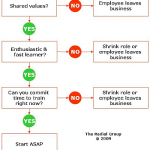Did you think online survey tools were just for opinion polls? Not true!
These tools are actually quick and easy ways for health clubs, yoga studios and wellness centers to spot problems, get customer feedback, and much more!
It’s cheap, too: you can get a free basic account at SurveyMonkey. And our Constant Contact clients can use the built-in survey module to survey their entire email list.
Below, our top five recommendations for using online survey tools to improve the performance of your health and wellness business:
1) Uncover retention red flags
Create a survey that asks the single most important customer feedback question.
Send this survey to people who have been members less than 30 days, and to people who have been members for more than 6 months. Compare the answers between the groups.
In general, the older customers should be more enthusiastic. If their responses are less favorable than your newest customers, you’ve got a problem that you need to investigate.
Is it poor service? An expectation gap between how you sold your services and what your club or wellness center actually delivers? Or something else?
2) Customer input on new products and services
Give current customers the opportunity to provide input on potential new services, like nutrition counseling or self-care seminars for specific health conditions.
What works best: asking people how (or if) they would use certain features.
For example, if you’re considering a smoothie bar, you might ask them if they’ve ever visited a Jamba Juice or ever fixed a smoothie at home. Then ask if they think they’d try a smoothie if your fitness center offered freshly-made ones.
What doesn’t work: asking them what they would pay for a new service. They’ll answer – but it’s usually unreliable information, and it isn’t a good predictor of what they’ll really be willing to pay.
3) Feedback on employees
Use a survey to get anonymous feedback on staff performance.
For example, when it’s time for annual performance reviews, create a survey requesting anonymous 360-degree performance feedback from selected subordinates and peers.
One successful approach is to create a two-question survey based on the “2+2” performance feedback strategy.
The first question asks peers and subordinates to identify two things that the person being reviewed does well. The second question asks them to describe two areas where they could improve.
Then send an email with the survey link to the people who’ll be providing feedback.
If your staff consistently works with the same clients, consider sending a feedback survey to them. For example, you might ask how quickly calls or emails are returned, or how well-prepared your health coaches are when they meet with the client, or whether your yoga instructors’ personal lives seems to affect their work with students.
4) Nurturing new business leads
Say you give a lunch presentation to a large group of local business leaders. Overt self-promotion is usually a no-no, but what you can do is invite people to download a complimentary case study or self-assessment that’s relevant to this audience.
Examples might include a case study of how a golfer improved his game, or how a local business improved employee productivity by reducing health-related absences. Or you might offer a case study of how one of your health coaches helped a client with Type 2 diabetes improve her lab results and reduce her need for medication. Or a self-scoring wellness quiz.
Set up the survey so that the first page captures their first and last name and email address. (Don’t ask for phone numbers and full mailing addresses – it just reduces the likelihood that people will respond. Step 1 is just to plant the idea of your business more firmly in their brains!).
Then present the quiz on the next page, or let them download the case study via a link to a PDF document.
5) Get content for your newsletter
A survey tool is also a quick and easy way to get content for your newsletter.
For example, you might ask members to submit a fitness tip that’s really worked well for them. Or the worst nutrition advice they ever got.
To increase the response rate, consider entering everyone who responds in a drawing for something fun.
Then, just compile the answers into a list and publish it in your next newsletter.


